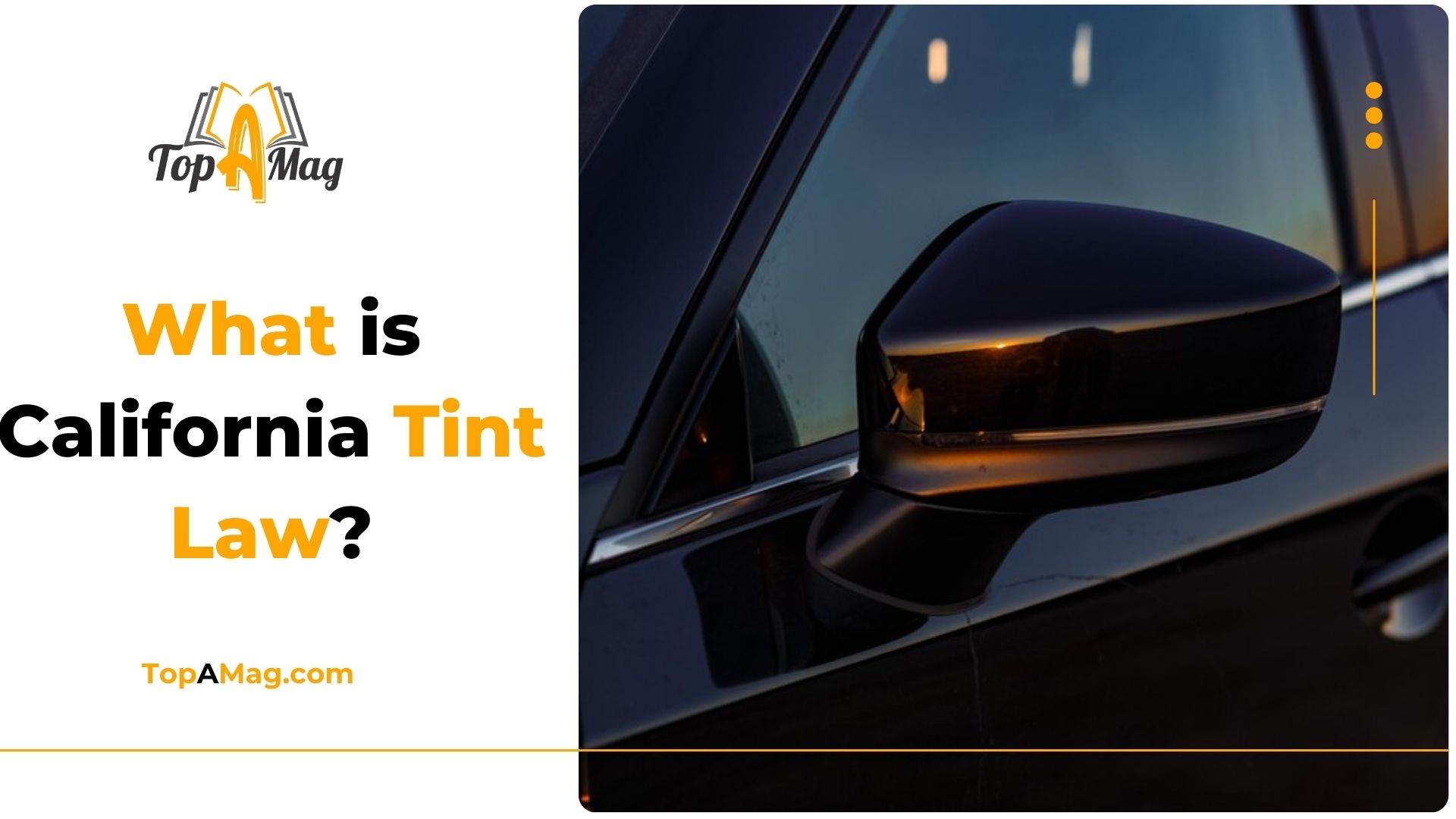Navigating the labyrinth of California Tint Law can be a daunting task for vehicle owners and enthusiasts alike. With stringent regulations governing the extent and type of window tint permissible, understanding these rules is crucial for compliance and safety. This article delves into the intricacies of California window tint law, offering a detailed analysis of legal requirements, exceptions, and the implications of non-compliance.
In this guide by The Top A Mag team, We will explore the legal landscape, types of tints available, and tips for ensuring you meet the legal requirements.
What is Window Tinting?
Window tinting refers to the application of a thin film or coating on vehicle windows to reduce glare, heat, and UV rays. This process not only enhances the aesthetic appeal of a vehicle but also provides privacy and comfort to occupants. The film applied can vary in terms of thickness, color, and material, affecting both its appearance and functionality. Window tints can help keep the interior of a vehicle cooler, protect upholstery from fading, and even offer a degree of security by making it harder for outsiders to see inside.
California Tint Law: An Overview
In California, window tint regulations are enforced to ensure safety and compliance with state laws. The California Department of Motor Vehicles (DMV) provides specific guidelines regarding the allowable levels of tint on various windows of a vehicle. These regulations goal to balance the blessings of tinting with the need for clean visibility for drivers and protection for all avenue customers. According to the Law, the Front-side windows of Vehicles must have 70% light transmission (VLT) or more
Legal Tint Limits for Passenger Vehicles
Under California law, the tint limits for passenger vehicles are determined by the type of window:
- Front Side Windows: Must allow at least 70% of outside light to pass through. This regulation ensures that drivers maintain clear visibility of the road and their surroundings, which is crucial for safe driving.
- Rear Side Windows: Tinting is allowed to a greater extent, with no specific limit set by law. However, the tint must not obstruct the driver’s ability to see out of the rearview mirrors. This provision allows for more privacy while still maintaining safety standards.
- Rear Window: The rear window can be tinted heavily, similar to the rear side windows, provided it does not hinder the driver’s rearview visibility. This flexibility is intended to offer greater privacy without compromising safety.

Exceptions and Special Considerations
Certain exceptions to the California Tint Law exist for vehicles that require special considerations:
- Medical Exemptions: Individuals with specific medical conditions that necessitate darker window tints can apply for exemptions. For instance, people with light sensitivity or certain skin conditions may need darker tints to protect their health. A doctor’s note and DMV approval are required to obtain this exemption.
- Tinting for Commercial Vehicles: Different regulations may apply to commercial vehicles, including those used for transporting goods or passengers. Businesses must be aware of the specific requirements for their fleet, which may differ from those for personal vehicles. This can include variations in the permissible level of tint on different windows.
Understanding California Tint Law and Tint Percentage
The tint percentage refers to the quantity of seen light that could pass via the window. For example, a 70% tint means that 70% of light can pass through, while 30% is blocked. California laws mandate that front-side windows allow a minimum of 70% visible light transmission (VLT). In contrast, the rear windows can have a darker tint, but it must not obstruct visibility.
Tint percentage is crucial because it affects not only the aesthetics but also the functionality of the tint. Darker tints can block more heat and UV rays, which can be beneficial, especially in sunny climates like California. However, they also reduce the amount of light that enters the vehicle, which can impact visibility and safety.
The Impact of Non-Compliance
Non-compliance with California Tint Law can lead to several consequences:
- Fines and Penalties: Vehicle owners may face fines if their window tint exceeds the permissible limits. These fines can vary based on the severity of the violation and the discretion of the regulation enforcement officer. Repeated offenses can cause higher fines and extra penalties.
- Vehicle Inspections: Vehicles found in violation of tint laws may be subject to inspection and required to have the illegal tint removed. This process can be time-consuming and costly, involving the removal of the existing tint and reapplication of compliant film.
- Increased Risk of Accidents: Overly dark tints can impair visibility, increasing the risk of accidents. Reduced visibility could make it more difficult for drivers to see pedestrians, other vehicles, and road signs. This risk underscores the importance of adhering to legal standards for tinting.
Tips for Complying with California Tint Laws
To ensure compliance with California window tint regulations, consider the following tips:
- Consult Professional Installers: Work with reputable tinting professionals who are familiar with California laws. They can help you select and install tints that meet legal requirements. Professional installers can also provide advice on the best types of tints for your needs.
- Check Tint Regulations Regularly: Laws and regulations can change, so it’s essential to live updated on any modifications to the tinting policies. Regularly check the DMV website or consult with legal experts to ensure your tint remains compliant.
- Document Medical Exemptions: If applying for a medical exemption, ensure that all necessary documentation is completed and submitted to the DMV. Keep copies of all correspondence and approvals in case you need them for verification.
- Use High-Quality Tint Films: Opt for high-quality tint films that not only meet legal requirements but also offer durability and performance. High-exceptional movies are less likely to fade or peel, ensuring long-term compliance and capability.
- Regularly Inspect Your Tint: Periodically check the condition of your window tint to ensure it remains compliant and free from damage. Any peeling or bubbling can be a sign that the tint needs to be replaced.

Popular Types of Window Tint Films
Several types of tint films are popular among vehicle owners:
- Dyed Window Tint: Offers a sleek appearance and reduces glare. This type of tint is made by applying a layer of dye to the film, which absorbs sunlight and reduces heat. However, it is able to not be as powerful in blocking heat as compared to other types.
- Metalized Tint: Provides excellent heat rejection and durability but can interfere with electronic signals. This type of tint contains tiny metal particles that reflect sunlight, reducing heat and glare. It’s known for its strength and longevity.
- Ceramic Tint: Offers superior heat rejection and UV protection while maintaining excellent clarity. It’s often the preferred choice for high-performance vehicles due to its high heat rejection properties and low impact on visibility. Ceramic tint is also less likely to interfere with electronic signals.
The Role of Window Tint in Vehicle Safety
Window tinting plays a crucial role in vehicle safety by:
- Reducing Glare: Tinting helps reduce glare from the sun and headlights, enhancing motive force comfort and reducing eye pressure. This can be particularly beneficial during sunrise and sunset when glare is most intense.
- Protecting Against UV Rays: Tint films block harmful UV rays, which can cause skin damage and accelerate the aging of the vehicle’s interior. This protection is essential for maintaining the health of occupants and the condition of the vehicle.
- Enhancing Privacy: Darker tints provide increased privacy for vehicle occupants, making it more difficult for others to see inside. This can be an important security feature, especially in urban areas.
Frequently Asked Questions (FAQs)
What is the legal tint limit for front-side windows in California?
The legal tint limit for front-side windows in California is 70% VLT, meaning at least 70% of light must pass through. This ensures adequate visibility for the driver.
Can I get a tint exemption for medical reasons?
Yes, you can apply for a medical exemption if you have a condition that necessitates darker window tints. Documentation from a physician is required, and the exemption must be approved by the DMV.
Are there different tint regulations for commercial vehicles?
Yes, commercial vehicles may have different tint regulations. It’s important to check the specific requirements for your vehicle type to ensure compliance.
What are the consequences of violating California Tint Law?
Consequences can include fines, vehicle inspections, and the requirement to remove illegal tint. Non-compliance can also lead to increased safety risks and potential legal issues.
How can I ensure my window tint complies with California laws?
Consult with professional tint installers who are knowledgeable about California regulations and check the tinting guidelines regularly. Regular inspections and using high-quality tint films can also help ensure compliance.
Can I legally have dark tint on my rear side windows?
Yes, rear-side windows can have darker tints without specific limits, provided it does not obstruct visibility through the rearview mirrors. This offers more privacy while maintaining safety standards.
What types of window tint films are available?
Popular types include dyed, metalized, and ceramic tint films. Each type offers different benefits in terms of heat rejection, UV protection, and durability.
How can I check if my window tint is compliant?
You can use a tint meter to measure the VLT of your windows or consult a professional installer for verification. Ensuring compliance helps avoid fines and other issues.
What should I do if I receive a ticket for illegal window tint?
Address the ticket promptly and take into account having the tint eliminated or adjusted to meet felony requirements. This will help avoid further fines and ensure compliance.
Are there any recent changes to California tint laws?
Laws can change, so it’s important to stay updated by checking with the DMV or legal resources. Regularly reviewing current regulations will help ensure ongoing compliance.
Conclusion
Understanding and adhering to California Tint Law is essential for vehicle owners seeking to enjoy the benefits of window tinting without facing legal repercussions. By staying informed about the legal limits, exceptions, and types of tints, you can ensure that your vehicle remains compliant and safe. Regular consultation with professionals and keeping abreast of legal updates will help you navigate the complex landscape of window tint regulations effectively.
In summary, proper knowledge and adherence to California window tint laws not only enhance your vehicle’s appearance and comfort but also ensure safety and legal compliance. Whether you’re considering tinting for privacy, aesthetic appeal, or heat reduction, understanding these regulations will help you make informed decisions and enjoy the full benefits of window tinting.

